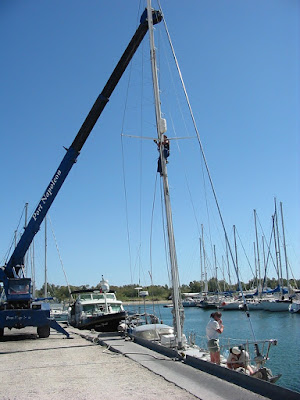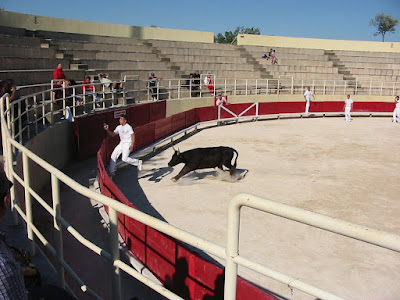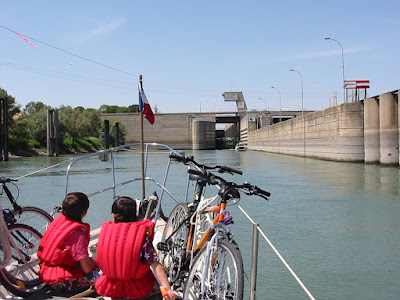 |
| French waterways overview |
Monday, May 29th - Removing our mast between spates of wind
 |
| Sails coming down to store. |
As soon as we arrive at the marina at Port Napoleon, near where the Rhône River drains into the Mediterranean Sea, we begin to remove sails and dismantle shrouds and lines on TIOGA in order to take her mast down.
 |
| Chris needs Gerrit's help to disconnect rigging. |
 |
| Removing TIOGA's mast in Port Napolean |
 |
| Preparing mast for transport. |
Tuesday, May 30th - Exploring the Camargue
 |
| Carmargue horse |
At the southern end of the Rhône River where we are, the region is called the Camargue, an immense delta famed for its desolate beauty and incredibly varied bird life, including huge flocks of flamingos. In certain areas, the Carmargue's famous herds of cream-coloured horses can still be found, along with the black bulls that are raised for bullfighting and roam free under the watchful eyes of the mounted gardian, a 'Camargue Cowboy'. We take a little time out from working on the boat to have a poke around.
 |
| Black bulls raised for fighting. |
Saturday, June 3rd - Another form of Bullfighting
 |
| Bull fighting French-Carmarguaise-style |
In this part of France, bullfighting is popular, but it's not the Spanish-style corrida where the bull ends up dead. Here, we are introduced to a junior Course Camarguaise (Camargue-style bullfighting) where white-clad razeteurs try to remove ribbons tied to the bull's horns with special hooks held between their fingers. Of course, the bull feels like skewering the razeteurs instead so the whole thing is more like bull racing with some great athleticism!
 |
| Joel and Gerrit watch from safety. |
 |
| Our trip up the Rhone & Saone |
For the remaining pictures in this log, you may find it useful to refer to this overview of the area covered in our trip up the Rhône and Saône Rivers.
Monday, June 5th - On our way!
 |
| First lock entering into the Rhone River from the Med. |
The mistral wind has finally let up and today we leave salt water and enter the fresh water river system of the Rhône. Our first lock is turbulent, not because of a great change in elevation (only 10 cm!), but due to the mixing of the salt and fresh water, waters of different densities. We are in great spirits to finally be underway.
 |
| Underway via motor only. |
June 5th - 8th - The City of Arles
 |
| Rafted up in Arles at the public quay. New bikes on pontoon. |
Tuesday, June 6th - Exploring Arles
 |
| Pretty cafes in Arles across from the Roman arena |
Arles is a pretty town. Initially occupied by Celtic tribes, then by a Greek colony, Arles became Roman when Julius Caesar gave the colony to the veterans of his armies. Several of the sights in town are on the UNESCO list of World Heritage Monuments, including a massive amphitheater built around 90 AD with seating for 20,000 spectators. Quaint and currently quiet cafes line the streets, but within a couple of weeks the place will be jammed for the Fetes d'Arles, the annual fair and bullfights (courses Camarguaises). Arles' most famous resident was the painter Vincent van Gogh (1853-90)
Wednesday, June 7th - Bike riding near Arles - RESCUE MISSION!
 |
| .Lamb caught up in bramble and barbed-wire |
Thursday, June 8th - Approaching our first lock on the Rhône and inside the largest drop lock in the world!
 |
| Approaching our first lock |
 |
| About to enter Ecluse de Beaucaire. |
At each of the plants, there is a dam and a lock such as the one we are approaching. (Ecluse means lock in English)
 |
| 22m - world record lock in terms of lift |
The locks are all standard dimensions of 195m by 12m wide and the fall (or rise in our case) varies between 6.7m and a stunning 22m, as shown here in the second locking picture (though further upstream). If you look closely at the expanded picture, you'll see us hooking our lines to a floating bollard. As the water goes up, so does our boat's connection point. Much easier to handle!
Approaching Avignon and its famous bridge
 |
| Avignon bridge |
Next up the river is the city of Avignon, known to us for the bridge in the famous French song “Sous le Pont d'Avignon”. Only a portion of the bridge 'Saint Bénézet' (12th century) remains, having been rebuilt and washed away countless times by the merciless Rhône during flood.
Friday, June 9th - Papal Palace in Avignon
 |
| Popes' palace in Avignon from 12th century |
From 1309 to 1377, Avignon served as the seat of the papal court when Pope Clement V fled political turmoil in Rome. Under seven French-born popes, huge sums of money were invested in buildings, decorating the papal palace, and on other important church edifies. Avignon flourished to the point of depravity. The last pope, Gregory XI left Avignon in 1376 and after his death two years later the church had a period (1378-1417) during which rival popes - up to three at one time, each with its own College of Cardinals - resided at Avignon and Rome and spent most of their energies denouncing and excommunicating each other. They also expended great efforts on gaining control of church revenues; one of the sources was the sale of indulgences (the promise of favorable treatment in heaven in consequence for sin on earth).
Nuclear energy
 |
| Nuclear power plants on the Rhone |
Monday, June 12th - Cruising up the Rhône from our helm station
 |
| Probably went aground in a flood |
 |
| Helm station for comfort |
With a normal travel day being about six hours per day, the helmsman needs to be comfortable, out of the blazing sun, and have a good forward view. Our bimini (cockpit cover) and zip-in sunshades keep us cool, two folding camping chairs with drink holders give us comfort and a good viewing location, and the auto-pilot reduces the effort to hand steer to adjusting the course control with a thumb and index finger. We keep our river navigation guide book on the cockpit table, a set of binoculars handy, and thoroughly enjoy the pace!
Tuesday, June 13th - Happy 19th Anniversary
 |
| Flan cake to celebrate. |
Wednesday, June 14th - Approaching vineyards - the Côtes du Rhône
 |
| Cotes du Rhone vineyards |
Thursday, June 15th - Arrival in the grand city of Lyon
 |
| Approaching Lyon |
Well, we finally make it to Lyon, situated at the confluence of the upper Rhône and the south end of the Saône River. Though the trip up the Rhône has been fabulous, we're not sad to be off it with its constant threat of flood and mistral winds.
 |
| Entering into the City of Lyon |
 |
| TIOGA rests peacefully on a quay in Leon. |
Lyon is also know for great gastronomy (yes, a fancy word for good food). In the heart of the center, we tie up on the quay, in the shade of trees, and in the good company of friends met downstream.
Friday, June 16th - OH CANADA!
 |
| Singing students from Lyon! |
Saturday, June 17th - Biking-by INTERPOL World Headquarters - Lyon, France
 |
| Interpol world headquarters |
FYI - INTERPOL or the International Criminal Police Organization has it headquarters in Lyon. Interpol was established in 1923 to promote mutual cooperation between police authorities around the world and to develop means of effectively preventing crime. The majority of the world's countries (177 in 1997) belong to Interpol, and only government-approved police bodies may hold membership. From these very headquarters, it coordinates the international activities of member countries, holds a library of international criminal records, and organizes regular meetings at which delegates can exchange information on police work.
Sunday, June 18th - Traboules - secret passages from Lyon's past
 |
| "Traboule" - a secret passage with many users |
 |
| Lazy elephants. |
We take in a zoo.
 |
| Tomorrow's Tour de France? |
Watch cyclists training in a Velodrome.
 |
| Joel gets good air and Gerrit is hot on his heels. |
The boys enjoy some time on their scooters, which have largely been unused since we got bikes.
We are getting ready to move on north.
Tuesday, June 20th - Swan and her brand new cygnets
 |
| Mama swan and her babies |
 |
| End of day cool off. |
We decide to join the swans and have a cool down swim in this lovely river. Better take advantage of the water now as once we enter actual canals it may not be so conducive to swimming.
Thursday, June 22nd - Exploring the Mâconnais wine-growing area
 |
| Prestigious grape vines everywhere. |
The town of Mâcon, on the right bank of the Saône River 74km north of Lyon, is our base to explore the Mâconnais, a southern Burgundy wine-growing area. (In the case of Burgundy, it is also an administrative region in France similar to a US state or Canadian province.)
Burgundy's red wines are produced with the Pinot Noir grapes in the centre, and the Gamay in the south. Most white wine is made from the Chardonnay grape. The five main wine-growing areas of Burgundy, generally from north to south, are Chablis, Côte d'Or, Côte Chalonnais, Mâconnais, and Beaujolais.
 |
| Biking the 'Les Voies Vertes" |
Throughout our area, there is a 117km paved cycling path called 'les voies vertes' (the greenway) along a former railway line and canal towpaths. For our day out, it runs through the vineyards connecting the country villages and we spend hours pedaling leisurely through the countryside, soaking in the scenery, and stopping from time to time at a 'degustation' (sampling & sales) point.
 |
| Cold beers and ice cream just won out |
 |
| Mont-Pouilly in the distance. |
A local points out Mont-Pouilly and her vineyards in the distant, but our compass will point home for supper. We read later that from the area surrounding the Pouilly outcropping come many famous vintage names, including the area's most highly prized vintage, the renowned Pouilly-Fuissé, a white that bolsters the Mâcon-area label worldwide.
Friday, June 23rd - Go-karting near Mâcon
 |
| Karting near Macon |
Sunday, June 24th - Cycling to Chardonnay Village
 |
| The village of Chardonnay - over 1020 years old! |
Today, the production from this area would be known as a Mâcon Villages - Chardonnay, meaning the region - or appellation - where the wine is from and the grape variety, and would be further refined by the name of the winery.
 |
| Chardonnay's vineyards |
As we cycle down into the village of Chardonnay, one can see abundant vines growing on the slopes of the valley. High quality wine-making requires dry growing conditions, from a slope without an underground water table and that does not hold water. At the other end of the adaptability spectrum from the Pinot Noir vine, the Chardonnay is said to be the cameleon of vines, as it can adapt to any growing environment in the world provided it has little water, and, with the slightest variation in soil or climate, produces wines that are 'remarkably specific and original and with amazing intensity'.
Monday, June 26th - Nicephore Niépce museum in Chalon-sur-Saône
 |
| Camera obscuras at the Niepce museum |
We are now in Chalon-sur-Saône (the town of Chalon on the Saône River), the birthplace of French inventor Joseph Nicéphore Niépce (1765-1833), who made the first permanent photographic images. Niépce used a 'camera obscura' (a forerunner of the camera), which is essentially a pinhole in a box. Light passes through the hole and forms an inverted, backwards image of the subject on the back of the box. The image is somewhat dim, but the detail sharp enough that properly placed film or plate might produce a photograph. Niépce continued his photography work and experiments and, in 1816, he successfully made the first surviving permanent photograph, of the courtyard of his house, using a bitumen-coated pewter plate exposed in a camera obscura.
 |
| Just a cool view of TIOGA |
Thursday, June 29th - Arrival in St Jean-de-Losne and start of the Bourgogne Canal!
 |
| Entrance to the Bourgogne Canal |
Join us in our log 49 for the ups and downs of this journey along the Bourgogne Canal.


